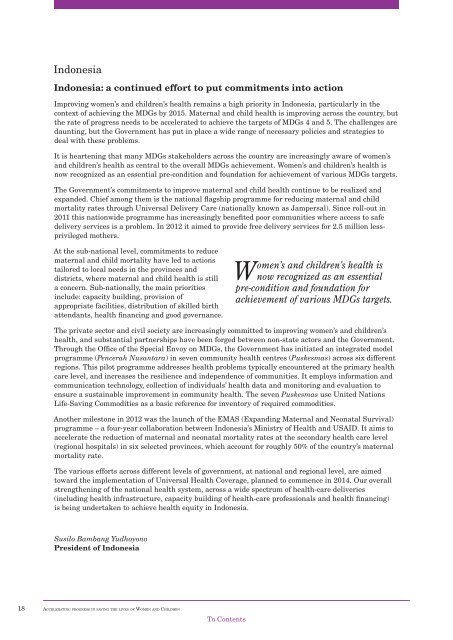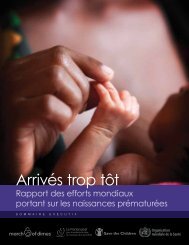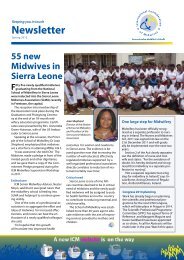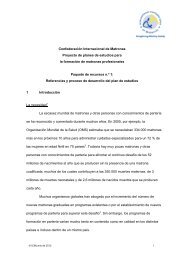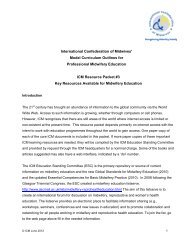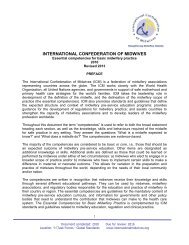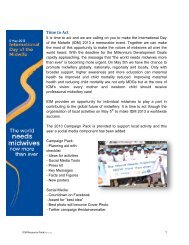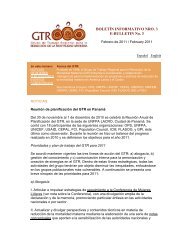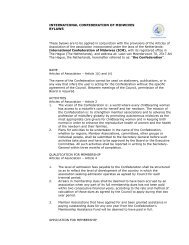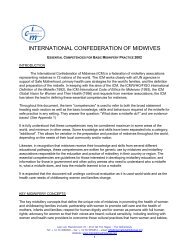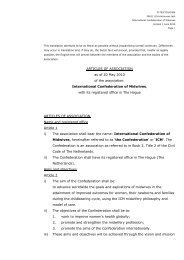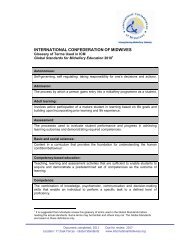Download the pdf of the report pdf, 2.78Mb - World Health ...
Download the pdf of the report pdf, 2.78Mb - World Health ...
Download the pdf of the report pdf, 2.78Mb - World Health ...
Create successful ePaper yourself
Turn your PDF publications into a flip-book with our unique Google optimized e-Paper software.
IndonesiaIndonesia: a continued effort to put commitments into actionImproving women’s and children’s health remains a high priority in Indonesia, particularly in <strong>the</strong>context <strong>of</strong> achieving <strong>the</strong> MDGs by 2015. Maternal and child health is improving across <strong>the</strong> country, but<strong>the</strong> rate <strong>of</strong> progress needs to be accelerated to achieve <strong>the</strong> targets <strong>of</strong> MDGs 4 and 5. The challenges aredaunting, but <strong>the</strong> Government has put in place a wide range <strong>of</strong> necessary policies and strategies todeal with <strong>the</strong>se problems.It is heartening that many MDGs stakeholders across <strong>the</strong> country are increasingly aware <strong>of</strong> women’sand children’s health as central to <strong>the</strong> overall MDGs achievement. Women’s and children’s health isnow recognized as an essential pre-condition and foundation for achievement <strong>of</strong> various MDGs targets.The Government’s commitments to improve maternal and child health continue to be realized andexpanded. Chief among <strong>the</strong>m is <strong>the</strong> national flagship programme for reducing maternal and childmortality rates through Universal Delivery Care (nationally known as Jampersal). Since roll-out in2011 this nationwide programme has increasingly benefited poor communities where access to safedelivery services is a problem. In 2012 it aimed to provide free delivery services for 2.5 million lessprivilegedmo<strong>the</strong>rs.At <strong>the</strong> sub-national level, commitments to reducematernal and child mortality have led to actionstailored to local needs in <strong>the</strong> provinces anddistricts, where maternal and child health is stilla concern. Sub-nationally, <strong>the</strong> main prioritiesinclude: capacity building, provision <strong>of</strong>appropriate facilities, distribution <strong>of</strong> skilled birthattendants, health financing and good governance.Women’s and children’s health isnow recognized as an essentialpre-condition and foundation forachievement <strong>of</strong> various MDGs targets.The private sector and civil society are increasingly committed to improving women’s and children’shealth, and substantial partnerships have been forged between non-state actors and <strong>the</strong> Government.Through <strong>the</strong> Office <strong>of</strong> <strong>the</strong> Special Envoy on MDGs, <strong>the</strong> Government has initiated an integrated modelprogramme (Pencerah Nusantara) in seven community health centres (Puskesmas) across six differentregions. This pilot programme addresses health problems typically encountered at <strong>the</strong> primary healthcare level, and increases <strong>the</strong> resilience and independence <strong>of</strong> communities. It employs information andcommunication technology, collection <strong>of</strong> individuals’ health data and monitoring and evaluation toensure a sustainable improvement in community health. The seven Puskesmas use United NationsLife-Saving Commodities as a basic reference for inventory <strong>of</strong> required commodities.Ano<strong>the</strong>r milestone in 2012 was <strong>the</strong> launch <strong>of</strong> <strong>the</strong> EMAS (Expanding Maternal and Neonatal Survival)programme – a four-year collaboration between Indonesia’s Ministry <strong>of</strong> <strong>Health</strong> and USAID. It aims toaccelerate <strong>the</strong> reduction <strong>of</strong> maternal and neonatal mortality rates at <strong>the</strong> secondary health care level(regional hospitals) in six selected provinces, which account for roughly 50% <strong>of</strong> <strong>the</strong> country’s maternalmortality rate.The various efforts across different levels <strong>of</strong> government, at national and regional level, are aimedtoward <strong>the</strong> implementation <strong>of</strong> Universal <strong>Health</strong> Coverage, planned to commence in 2014. Our overallstreng<strong>the</strong>ning <strong>of</strong> <strong>the</strong> national health system, across a wide spectrum <strong>of</strong> health-care deliveries(including health infrastructure, capacity building <strong>of</strong> health-care pr<strong>of</strong>essionals and health financing)is being undertaken to achieve health equity in Indonesia.Susilo Bambang YudhoyonoPresident <strong>of</strong> Indonesia18Accelerating progress in saving <strong>the</strong> lives <strong>of</strong> Women and ChildrenTo Contents


